"Why on earth are you going to Houston?" our friends asked. It was more like a judgement than a question and we were on the receiving end way more than once.
This was before we went and to tell the truth, we really didn't have a very good answer. It would be an opportunity to dig up new stories in a place we'd never been, although we'd certainly heard the same not-so-flattering rumors about this "cow town."
Now that we've been to Houston, we not only have lots of very good answers but also some great reasons to visit and many interesting stories to share.
The Society of American Travel Writers recently had its annual meeting in Houston and we found that the city and its environs are actually loaded with things to do, even things tourists love to do. Plus there are a lot of good activities unknown to visitors, yet.
That's where we travel writers come in. Four hundred of us came in to Houston for a week and got to do short bursts of all kinds of recreation unfamiliar to us. We picked from a vast menu of activities, broke into groups of ten or twenty and headed out with guides to do short versions of the things we picked.
Those included the museum district, theaters, multicultural markets, diverse houses of worship, the Houston Polo Club, Space Center Houston, tours of arboretums, bayous and swamps, upscale shopping, dragon boat race, pontoon tour, BBQ tour, African-American soldiers museum, Texas Medical Center, gay bar & club tour; the list goes on.
What follows are two activities done in the same day, a dawn bike ride through
the city and a glider flight about an hour north.
 |
Forty-five of us joined Houston mayor Bill White and his staff for a 6 a.m. city ride before breakfast. Ten miles. Also along for the ride, a bit shorter than his usual MS-150 (mile) rides, was Barry Goldware, CEO of adventure sports outfitter Sun & Ski Sports which provided the bikes, helmets and lights for the Houston ride. |
 |
|
| No one mentioned this part of the ride—through the Glenwood Cemetery. Eek. Howard Hughes resides here, and his memorial is the most visited tourist site in Houston. |
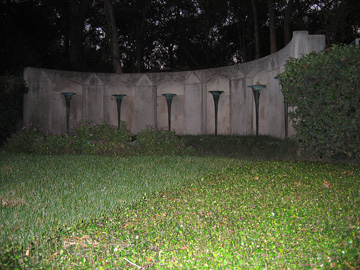 |
|
|
Howard Hughes memorial in Houston's Glenwood Cemetery
|
Click here to watch a video of Mayor White in front of Howard Hughes' memorial, discussing
Houston parks
 |
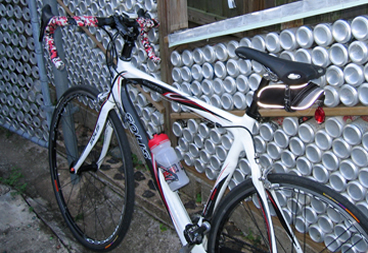 |
Just a bout the time that cup of early morning coffee was sounding pretty good,
we stopped at one of the city's treasures, the Beer Can House, for hot Starbuck's
and local TexMex breakfast fare. Kind of surprising we didn't have a beer since
the house and its surrounding grounds, preserved by a folk arts organization,
is outfitted with nearly 50,000 beer cans.
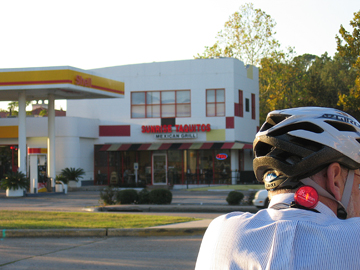 |
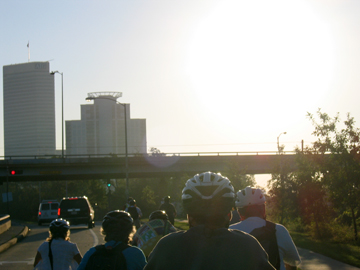 |
About sunrise we headed back into downtown on scenic Allen Parkway, the main
highway, with views of Buffalo Bayou and the Houston skyline. Remarkably, we
saw very few vehicles and had free and clear run of the roads.
Mayor White, who cycles nearly every weekend, launched the annual Tour de Houston, a 70-mile bike ride through the whole city, inspired by New York's Bourough to Bourough ride. We were lucky enough to have gotten the mini-Tour de Houston that morning.
Houston has an extensive bikeways program encompasing a 345-mile interconnected
bike path network throughout the city. Go to www.houstonbikeways.org for lots
more information.
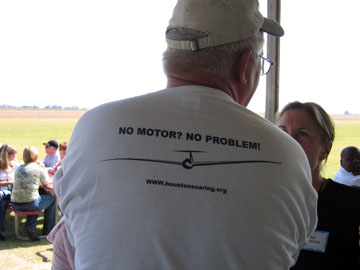 |
|
| Moving right along to another non-motorized sport—soaring in a glider with the Greater Houston Soaring Association. |
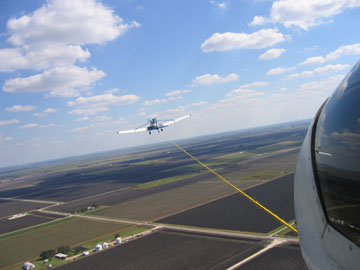 |
|
|
Tow job, up to 2,000 feet or so.
|
The pilot sitting behind me said we'd be disconnecting in another hundred feet
or so, and Oh, would I mind pulling that yellow lever? Nah, I didn't mind, pulled
it and watched as the yellow tow rope sailed away from us. He agreed I wouldn't
have pulled it if I knew what I was doing...
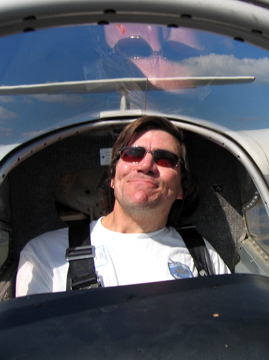 |
|
| This pilot enjoys a good flight as much as a good joke. |
I don't have pics, only video, of what happened when he asked if I enjoyed
roller coasters. As I was composing a qualified answer we spun hard over and
spiraled down a ways, the n the other way. Stomach did churn some. No loops,
just basic dive bombing, although the pilot said it was NOT dive bombing because
we didn't drop anything. Some ships are made for aerobaticals, but not today's,
although in the hanger was a $160,000 number with insanely long wings and an
engine + receding propeller to get off the ground without help.
Click here for the video from my glider flight with the Greater Houston Soaring
Association on October 19, 2008.
The Greater Houston Soaring Association has 120 members—115 men and 5 women. They all have day jobs to support their weekend soaring habits. Volunteer-run, the group offers introductory rides for $75. They also teach. It takes about one year and $2,000 to become licensed, one-third of what it costs to learn motorized flying. The age range of students so far is 10-70+.
On a good thermals day, a glider can soar for up to 500 miles, traveling up
to 130 mph. Pilots may need to pack some food and water, and perhaps a pee tube.
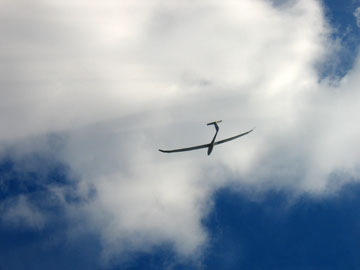 |
|
| Another "ship," climbing the thermals. |
Soaring records are:
Elevation—49,009 feet
Distance—2,000+ miles
Speed—145.9 mph on a closed course
A usual glide ratio is 28 to 1, meaning in still air the ship will lose only
one foot of altitude for every 28 feet that it glides. Some exceptional gliders
have a 60 to 1 ratio.
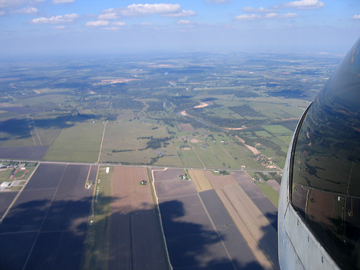 |
|
|
A glider always wants to descend. The trick is to find
air, a thermal, that is rising faster than the glider's rate of descent.
Thermals often occur under clouds and over dark soil. Pilots say that
you can feel a thermal in the seat of your pants.
|
Pilots keep an eye out for turkey vultures—"nature's perfect thermal machine." If a turkey vulture or two are soaring, chances are they're riding a good thermal, but some pilots swear that the birds play tricks by luring them to less-than-good air uplifts.
To begin soaring, the glider needs help to get up to around 2,000 feet of elevation. The usual method is to be towed by another airplane, one with an engine. Cessna Ag Wagons with 250 horsepower do the job very well (they're actually cropdusters).
Ships can also be launched by winch or towed behind a speeding car, and it's
rumored that a group on the West Coast uses a bungy cord to launch gliders.
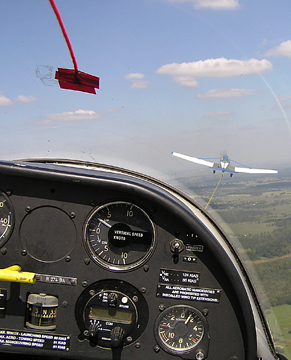 |
|
|
The most important flight instrument on a glider
is the yaw string, the short piece of bright string taped to the outside
front of the fuselage. The object is to keep the string parallel to or
in line with the direction the ship is going.
|
A ship can cost from $5,000 to $250,000. One hybrid ship comes with a motor for self-launching.
Glider pilots liken flying in a motorized aircraft to "driving with wings" and "drilling a hole in the sky."
There doesn't appear to be much risk to gliding other than bumping into each
other. They're towed high enough to get a good head start in the thermals and
they need only 300-500 feet of ground to land.
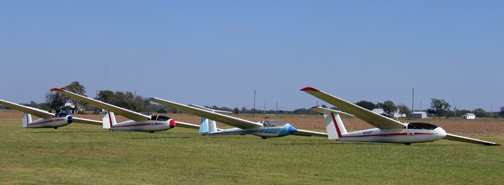 |
|
|
The thing about gliding is that it's so fun, not
to mention quiet. To soar like a bird is to ennoble to the spirit
|
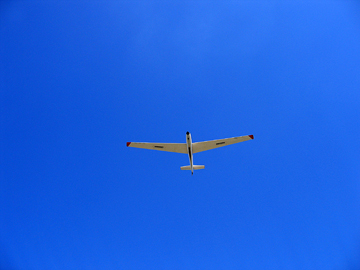 |
|